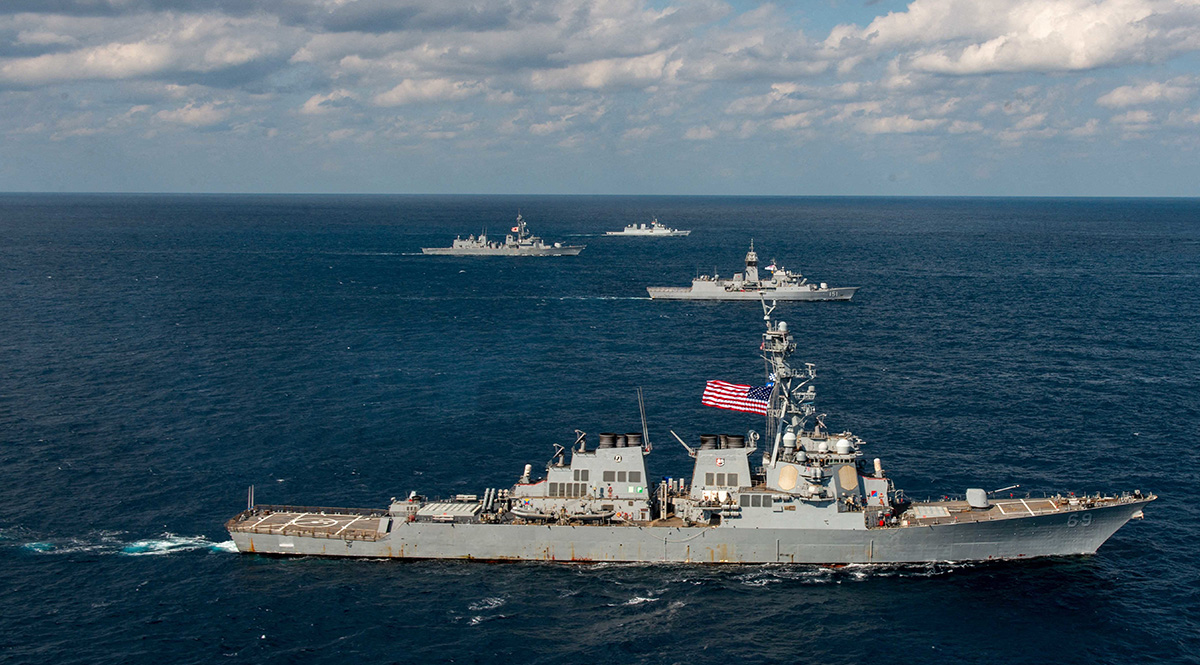EU Member States, U.S. Maintaining Sea Lanes in the South China Sea
The U.S. Navy’s freedom of navigation operations are designed to support free passage in disputed waters. In the South China Sea, they have become one of the tools for signalling U.S. opposition to Chinese claims to most of the maritime area. European countries are also carrying out similar activities, in line with the EU’s Strategy for Cooperation in the Indo-Pacific, among other aims. The involvement of EU and NATO member states in these operations will promote the maintenance of security in the region and strengthen transatlantic cooperation vis-à-vis China.
 ABACA / Abaca Press / Forum
ABACA / Abaca Press / Forum
The South China Sea is one of the most important transport routes connecting Europe, the Middle East, and East Asia. It carries around 30% of global trade by volume. Any problems with the flow of ships translate into, among other things, higher prices and shortages of needed goods in Europe, such as raw materials and production components. The South China Sea is also an area of long-standing disputes between Brunei China, the Philippines, Malaysia, Taiwan, and Vietnam. The militarisation of the basin by China—which claims almost the entire sea as its territorial waters—through the construction of artificial islands and military installations has been ongoing since 2013. Similar actions, albeit on a much smaller scale, have also been undertaken by the Philippines and Vietnam. In 2016, at the request of the Philippines, an arbitral tribunal acting under the UN Convention on the Law of the Sea (UNCLOS, signed in 1982, entered into force in 1994) ruled that China’s claims over the South China Sea were unlawful. However, China has denied the legality of the tribunal’s actions and does not recognise its ruling, instead continuing its policy of restricting other states’ freedom of action in the sea. The exacerbation of the situation in the South China Sea is also influenced by China’s naval and air activity around Taiwan.
U.S. and European Operations
Although the United States has not ratified UNCLOS, by invoking common law as reflected in the Convention, it conducts “Freedom of Navigation Operations” (FONOPS). The primary task of FONOPS is to ensure free passage through disputed waters. This is to facilitate, among others, international trade and the movement of U.S. forces. In 2022, operations were conducted in 22 locations around the world, including the Caribbean and the Mediterranean. Mostly, however, they are taking place in the South China Sea. Guided by FONOPS, U.S. naval units sail to within 12 nautical miles (beyond which it is considered territorial waters under international law) of China’s artificial islands and military installations which China claims are the outer markers of its wider territorial sea zone designation. The same aim is served by the U.S. refusal to identify when requested by the Chinese side any warships that, according to the United States, are sailing in international waters.
Under U.S. doctrine, FONOPS are not an expression of support for either side in a territorial dispute. They have been conducted in the South China Sea regularly since 2017, with estimates indicating that 61 missions have taken place in the basin between July 2018 and January 2024. In addition to the legal and political dimensions, they also serve to develop the U.S. Navy’s operational capabilities, including cooperation with partners. An example of this was the joint America-led exercise conducted on 7 April with its treaty allies Japan, Australia, and the Philippines, which also have been conducting similar operations in the region for many years.
The EU identified FONOPS as an important instrument for stabilising the region in its Indo-Pacific Cooperation Strategy, presented in 2021. FONOPS was been similarly identified in the documents of several European countries (France, Germany, the Netherlands, the Czechia, and the UK). The EU strategy identifies the securing of maritime transport lines of communication and the presence of Member State navies on these routes as part of building a regional security architecture based on international law. This can be interpreted as opposition to China’s escalatory policy. The involvement of individual countries is voluntary. The EU and its members are not copying the U.S. FONOPS, but attempting to create their own model of operation in line with UNCLOS.
The EU’s Indo-Pacific strategy follows practices already followed by individual Member States that are party to UNCLOS and treat naval operations in the region as part of their support for international law. France, which has overseas territories in the region, regularly (2-3 times a year) engages its ships in operations in the South China Sea, including exercises with partners and single patrols. Among other actions, it plans to send a group of ships with the aircraft carrier Charles de Gaulle to the area in 2025. Germany is also participating in similar operations. In 2021, the frigate Bayern made a six-month cruise in the region, including participation in exercises with vessels from the U.S., South Korea, Australia, and Japan, as well as transiting the South China Sea. Another German ship is due to make a similar cruise in 2024. The Netherlands sent the frigate Evertsen to the South China Sea in 2021, including on a joint cruise with the British aircraft carrier group led by the Queen Elizabeth. The UK plans to deploy this group again to the South China Sea in 2025. Also, the Italian aircraft carrier Cavour and its support ships are to take part in operations in the region from June this year.
China’s Reactions and Position
China, a party to UNCLOS, officially emphasises its lack of desire to restrict trade flows in the region and its support for freedom of navigation both in the South China Sea and around Taiwan. This is an important trade route for China, accounting for just under 40% of its total trade, including around 80% of its energy imports. However, China states that the use of sea lanes must not infringe on its sovereign rights over the South China Sea and Taiwan. The Chinese also declares that military units must not be involved in activities in these waters. The legal basis is provided by China’s 1992 Territorial Sea and Contiguous Zones Law. It seeks to enforce its demands by identifying, verifying, and attempting to divert U.S. and other countries’ ships and aircraft. So far, only once, in 2018, have the Chinese succeeded (through dangerous collision-threatening manoeuvres) in diverting a U.S. vessel engaged in a freedom of navigation operation. Limited restrictions are also applied to European actors, for example, by refusing to allow ships that participated in FONOPS into Chinese ports.
In recent months, both China and the U.S. have sought to limit the possible negative effects of actions in the South China Sea. This is due, among other things, to the return of direct communication between U.S. and Chinese military commanders in the region, agreed in November 2023 during the Xi-Biden meeting in San Francisco. It is intended not only to prevent inadvertent escalation of the situation due to accident or misunderstanding, but also—and especially from China’s perspective—to reduce anti-China issues in the U.S. presidential campaign.
Conclusions and Outlook
The participation of vessels from the U.S. and EU countries in naval operations in the South China Sea comprise a tool to comply with international law. It also supports the interests of the Union and its partners, including ASEAN countries, in the face of China’s wide territorial claims and militarisation of the basin. These operations (although conducted at the Member State level) add credibility to the EU’s cooperation with Asia-Pacific countries, developed, for example, in terms of arms supply and combating hybrid threats. This signals the interest of EU states and its partners, including the UK, in improving security in the region in response to the threat from China.
European states have limited capabilities for military engagement in the South China Sea compared to the U.S. or China, however their potential is significant in cooperation with the countries of the region, for example in cybersecurity, maritime training, or infrastructure development, including for military purposes in the region. U.S.-EU cooperation in this context is already taking place in the framework of CRIMARIO (established in 2015, an EU initiative to cooperate with local partners in the building maritime security capabilities in the Indian Ocean, extended to the Pacific from 2021) and in the joint EU-U.S. naval exercises in March 2023 in the Arabian Sea. Extending cooperation to the South China Sea, even with a limited presence of military units from EU states, would confirm transatlantic cooperation in the face of threats posed by China’s policies and would have a stabilising effect on the situation in the area. It would also have a positive impact on European security. Possible destabilisation in the South China Sea or around Taiwan could be seen by the Russian authorities as a convenient opportunity for further offensive actions in Central and Eastern Europe. The involvement of EU states in an area important for the international position of the U.S. also makes the case for maintaining a strong U.S. presence in Europe, especially in the face of the threat from Russia.





